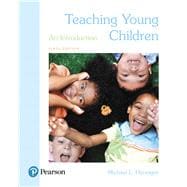NOTE: Used books, rentals, and purchases made outside of Pearson
If purchasing or renting from companies other than Pearson, the access codes for the Enhanced Pearson eText may not be included, may be incorrect, or may be previously redeemed. Check with the seller before completing your purchase.
This package includes the Enhanced Pearson eText and the bound book version.
This comprehensive text gives pre-service early childhood educators a balanced, accessible introduction to early childhood education that also covers the content areas. It shows readers how to teach and care for children by identifying and focusing on five essential elements: understanding child development, play, guidance, working with families, and diversity. Each essential element is addressed in its own separate chapter and then explored at a deeper level in a featured section in ever chapter.
Included is a rigorous overview of the planning, preparation, and delivery of a curriculum for young children built around six specific curriculum areas, each explored in its own chapter. The author stresses the importance of play and the need to nurture each child’s natural affinity for learning through experimentation and exploration. Separate chapters cover the importance of the outdoor environment and the effect of technology on early childhood education, giving future teachers a well-rounded look at delivering quality early education. Short vignettes help students better understand young children; numerous practical examples of developmentally appropriate strategies provide tools for actual classroom teaching; and supplemental resources assist instructors in presenting the course.
The Enhanced Pearson eText features embedded videos and check your understanding quizzes.
Improve mastery and retention with the Enhanced Pearson eText*
The Enhanced Pearson eText provides a rich, interactive learning environment designed to improve student mastery of content. The Enhanced Pearson eText is:
- Engaging. The new interactive, multimedia learning features were developed by the authors and other subject-matter experts to deepen and enrich the learning experience.
- Convenient. Enjoy instant online access from your computer or download the Pearson eText App to read on or offline on your iPad® and Android® tablet.*
- Affordable. Experience the advantages of the Enhanced Pearson eText along with all the benefits of print for 40% to 50% less than a print bound book.
*The Enhanced eText features are only available in the Pearson eText format. They are not available in third-party eTexts or downloads.
*The Pearson eText App is available on Google Play and in the App Store. It requires Android OS 3.1-4, a 7” or 10” tablet, or iPad iOS 5.0 or later.
0134013719 / 9780134013718 Teaching Young Children: An Introduction, with Enhanced Pearson eText -- Access Card Package, 6th Edition
Package consists of:
- 0134449959 / 9780134449951 Teaching Young Children: An Introduction, Enhanced Pearson eText -- Access Card, 6th Edition
- 0134569997 / 9780134569994 Teaching Young Children: An Introduction, Loose-Leaf Version, 6th Edition








